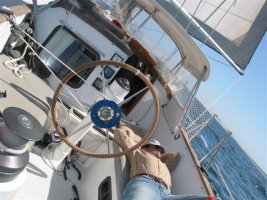Loren,
I was aware of the effect of radio trasmissions on autopilots, and was frustrated that I could never correlate our "excursions" with anything that we seemed to be doing.
And Ethan - as for the desirabiltiy of interfacing your GPS with your autopilot, I can think of few topics around the yacht club that tend to get people more worked up. (Even worse than which anchor is best.)
When I am crossing Lake Huron at night and have nothing to refer to except the GPS, I figure I am trusting it, so I might as well let it steer the boat as well. It saves a lot of effort trying to get the cross track error down by diddling with the exact magnetic heading on the autopilot. And if it steers poorly, it will show up in the cross track error anyway. BUT, I am in the cockpit all the time, never use the autopilot if we are close to anything hard (boats or land), check the cross track error every ten minutes, and every half hour I plot my position on the chart below and cross check the main GPS with the back up and the LORAN to see that they all agree.
With all those precautions I still have friends who say what I am doing is unsafe. I figure the real issue - once the autopilot is engaged - is how good a lookout you keep, and how well you monitor your position, whether you do it strictly by chart position or by cross track error.
Boat US has those insurance stories they publish about how things go wrong on the water. And a few months back one of them was a grounding that was caused by a boat motoring along on the intracoastal under AP when their AP took it's own "excursion" 90 degrees right into the shore before anyone could get to the helm. Having learned not to trust my own AP, I can't imagine ever trusting an AP in a narrow channel or river. But lots of folks do it.

